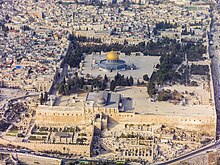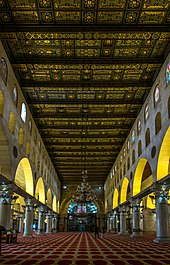Waqf Authority Jerusalem

The Jerusalem Waqf Authority is an inalienable Islamic foundation . She supervises the holy Islamic sites on the Temple Mount in Jerusalem made even after Israel in the Six Day War , the Old City of Jerusalem conquered. She is also responsible for the administration of the Abraham mosque in the patriarchal tomb in Hebron .
History since 1948
After the Palestine War in 1948, the old city of Jerusalem came under Jordanian control with the ceasefire agreement of 1949 . The Jordanian state appointed the Grand Mufti of Jerusalem and the head of the Supreme Islamic Council and paid the employees of the Waqf.
A few hours after the Israeli conquest of Jerusalem's Old City in the Six Day War in 1967, Defense Minister Moshe Dayan entrusted the Waqf with the management of the Muslim holy sites and banned the use of these sites for Jewish prayers. To this day, this resolution forms the basis for the status quo on the Temple Mount.
As part of the Israeli-Jordanian peace treaty of 1994, Israel and Jordan signed the Washington Declaration , according to which Israel "respects the role of the Hashemite Kingdom of Jordan in the holy Islamic sites of Jerusalem". The PLO, led by Yasser Arafat, opposed the role of Jordan on this point and in turn claimed control of the administration of the Islamic sites in Jerusalem. At the Casablanca Conference in December 1994, the Organization for Islamic Cooperation supported the Palestinian position and advocated transferring Jordanian powers to the Palestinian Authority . When the seat of the Grand Mufti of Jerusalem became vacant in October 1994, both the Jordanian and Palestinian sides appointed a successor. Eventually the Arafat appointed Sheikh Ikrima Sa'id Sabri received the post. In the January 1995 agreements between Jordan and the Palestinian Authority, the question of control over the Islamic sites on Haram escharif was completely ignored.
Since 2000 tourists are no longer allowed to enter the Dome of the Rock and the Al-Aqsa Mosque on the Temple Mount.
literature
- deutschlandradiokultur.de: Excavations in the Holy Land: Archaeological science in the shadow of politics (Sebastian Engelbrecht)
- Short Guide to the Dome of the Rock and Al-Haram Es-Sharif; Published by the Awqaf high authority. Jerusalem 1966
- Marshall J. Berger and Ora Ahimeir (eds.): Jerusalem: A City and Its Future , Syracuse University Press, 2002. Chap. 5, Menachem Klein: Rule and Role in Jerusalem (Eng.)
Footnotes
- ^ Marshall J. Berger and Ora Ahimeir: Jerusalem: A City and Its Future , p. 148.
- ↑ deutschlandradiokultur.de: Excavations in the Holy Land: Archaeological Science in the Shadow of Politics (Sebastian Engelbrecht)
